Menu
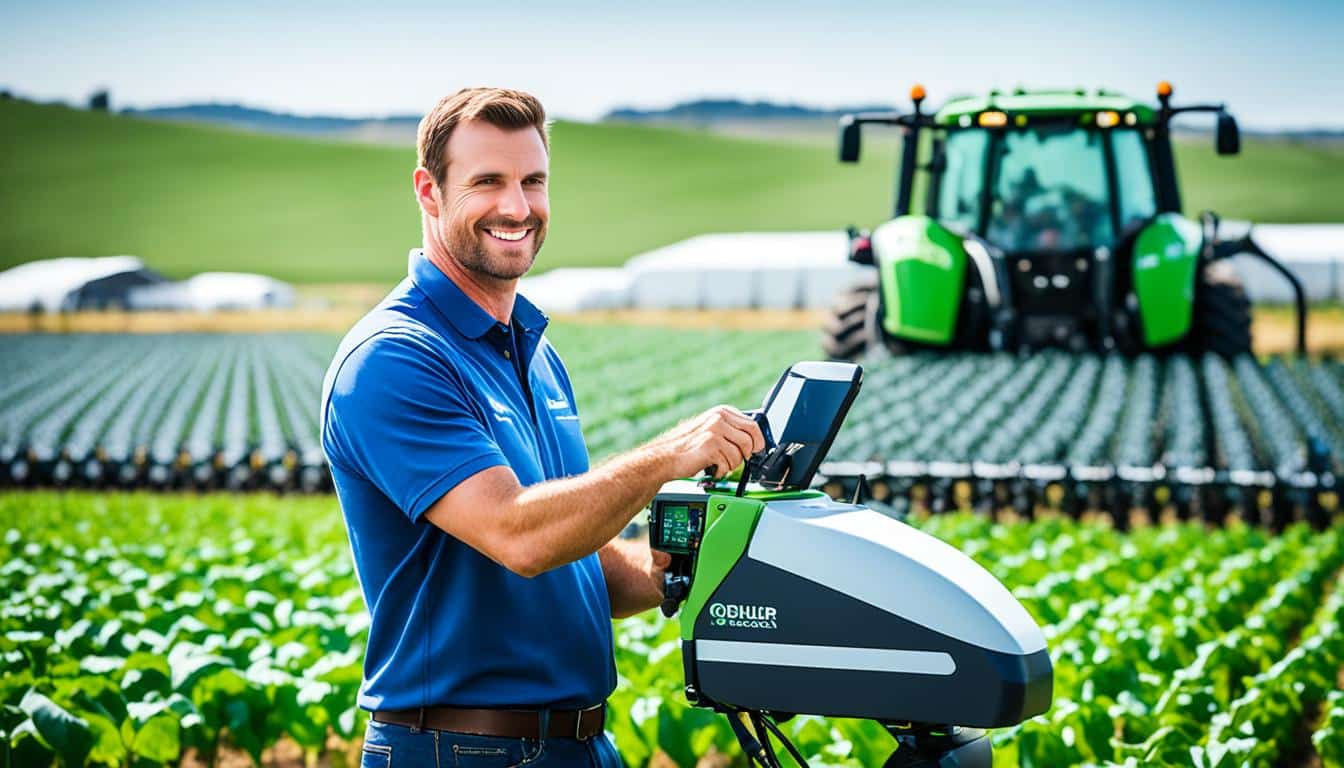
Farming ranks high for workplace injuries, illneses, and deaths around the world. This shows the urgent need to improve worker safety in agriculture. Advancements in machinery and automation have boosted productivity. But, using these technologies has become more complex, requiring better focus and decision-making.
We need farming tools that are easy to use and don’t tire workers out. This is vital because the agricultural sector still sees a lot of work-related accidents. It’s important to focus on trends in agricultural ergonomics to make work both productive and safe.
Agricultural ergonomics is about making farm work fit better for people. It aims to cut down on health issues and keep farm workers safe. This includes making tasks like lifting easier to avoid problems like back pain.
Farm work is risky, with many getting hurt or sick each year. The most common health worry for farm workers is back pain. It happens a lot because of tasks that need bending over a lot.
How tasks are done can make a big difference. For example, changing how grapes are picked or how orchards are climbed. Using better tools, like hoes with long handles, can reduce the pain farm workers feel.
Knee and hip problems are big concerns for those working in farming. The more someone bends their knees a lot, the worse it can get. Special tools can help those with bad knees do their jobs better.
Making farm work easier and safer also saves money. Studies show this is really important for both the worker’s health and the farm’s success. So, looking after workers better is good for everyone.
Overall, improving farm tasks helps reduce health issues and boosts farm success. It looks at things like how people sit or lift things that can cause harm. By making tasks safer and more comfortable, the chance of getting hurt or sick goes down a lot.
Today, advanced technologies like artificial intelligence and wearable devices are changing farming. They help with challenges like work injuries and the need for more efficiency. By using these new tools, how we check and improve work safety is evolving.
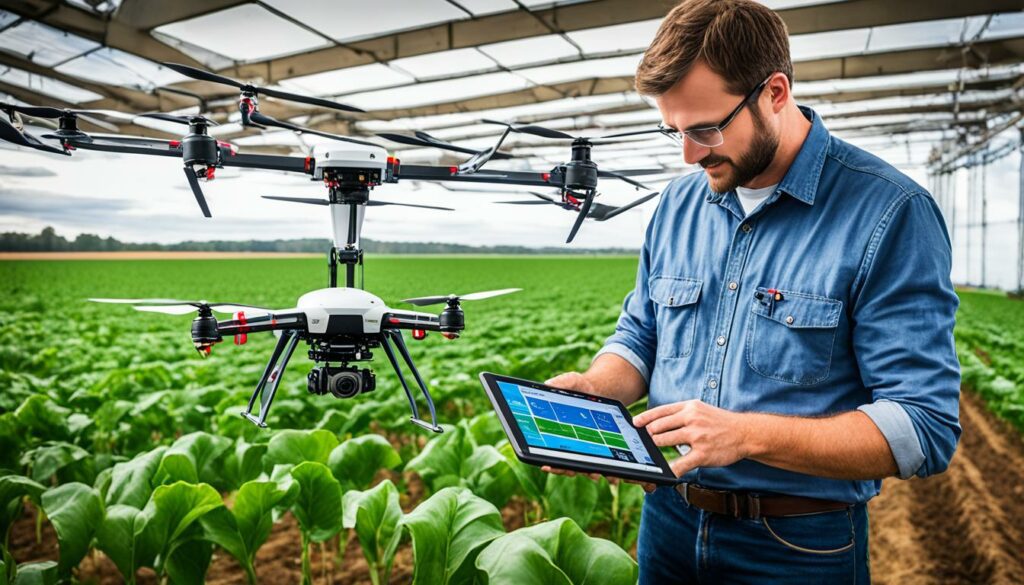
Artificial intelligence (AI) is innovating how we look at work risks in farming. Old ways of checking problems with work tasks, like the Nordic Musculoskeletal Questionnaire, now have AI support. So, we get real-time data on how people move. With computer vision and machine learning, we can see how someone is sitting or lifting things accurately. This makes checking work safety better and helps prevent muscle and joint issues caused by work. Work by the University of Illinois shows that AI is really making a difference in farm safety.
Wearable tech is also making a big difference in farming. These devices track how people move and work. Then, they use this data to check for work safety risks. Research by Elliot K.C., et al., (2022) shows that looking at how people work can reduce tiredness and bad posture problems in farming, forestry, and fishing. So, using wearable sensors helps keep workers safer and healthier. This means a more efficient and better workforce.
| Year | Reported Cases | Study/Source |
|---|---|---|
| 2000 | 463-480 | McCurdy S.A., Carroll D.J. |
| 2013 | 975-984 | Liebman A.K., et al. |
| 2022 | 898-912 | Elliott K.C., et al. |
AI and wearable tech are a big step forward for farming safety and efficiency. They make checking safety better and help workers be safer and more productive.
Sustainable farming is now a key part of agriculture, looking at the environment and people’s health. It includes ways to make farm work easier and safer, to avoid health problems like sore muscles and bad backs. Because farming can be risky, these improvements are very important to keep workers safe.
Working in awkward positions for a long time, like when weeding or lifting, can hurt our bodies. These activities can cause back pain and other issues over time. Now, sustainable farming uses smart designs in tools and work setups to stop these health problems. For example, changing the size of buckets for picking grapes or making ladders safer.
Changing the tools farmers use can make a big difference. Tools like long-handled hoes and special cutters that are easier to use can help a lot. Workers have less pain and can work better. So, looking after the workers is as important as protecting the land in sustainable farming.
New tech helps us figure out the best ways to keep farmers healthy while they work. It checks how they move and offers specific advice. This kind of help is great for making sure everyone stays well and works hard.
| Ergonomic Intervention | Reduction in MSDs |
|---|---|
| Smaller tubs for harvesting | Significant |
| Reduced ladder rung spacing | Significant |
| Long-handled hoes | Significant |
| Pneumatically-powered cutters | Significant |
Caring about the health of farm workers is still a big focus in research. The aim is to make farming safe and healthy for everyone working there. This way, farms can be both productive and good for the people who work on them.
In farming, humans working with machines is more important than ever. It’s not just about taking over human jobs. It’s about making work easier and safer, while improving how much we can do. Robots that work alongside us in farming help cut down hard physical work. They also make tasks finish quicker.
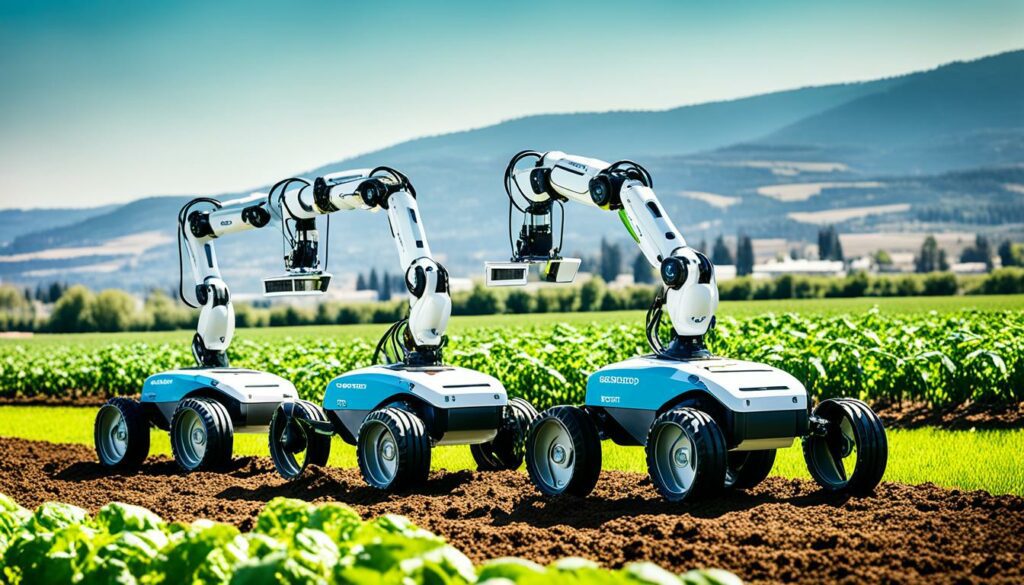
Designing automation to fit well and work safely is key in farming. Farming is known for its risks, so reducing these is critical. While machines have helped, we need to make sure working with them is safe and easy.
Issues like muscle and joint pains are big problems, causing health and money loss. Using robots in farming stops people from doing hard, repeating jobs. But, the machines need to work hand in hand with workers to make everything smooth and follow the right safety steps.
Automation aiming for ergonomic farming builds systems that are less tiring and safer for workers. Robots are perfect for ‘dull, dirty, and dangerous’ tasks, common in farming. But, there are still challenges. Things like planning paths, checking ground, and making sure machines and people work well together are big tasks.
Working with robots in farming brings many good points:
How safe people feel working with robots heavily depends on what happens, how much they control it, and clear rules. Making sure worker-robot teams are safe and effective is critical. This pushes our farming practices to be safer and better in the future.
| Challenges | Solutions |
|---|---|
| Route planning complexities | Advanced AI algorithms |
| Terrain assessment | Real-time data analytics |
| Worker detection | Enhanced sensor technologies |
| Handling delicate operations | Precision robotic systems |
Ergonomic machinery design is key in today’s farming world. More advanced farming tools mean we need to focus on making them user-friendly and safe. In the past, farm machines often were not well designed. This caused problems for the people using them and even their health.
Research has identified and assessed 1956 records related to ergonomic research in agricultural machinery. After removing 185 duplicates, 1769 titles and abstracts were examined, and 1152 studies were excluded based on initial screening criteria.
So, 617 studies were looked at even more closely. Since 1980, we’ve been finding about 2.89 good studies each year. But the number has gone up since 2018. It shows how important it is to design farm tools well. For example, between 2010 and 2018, in Italy, nearly 75% of deaths were linked to not using tractor safety parts properly.
Studies have also found that some tractors are not safe or comfortable for farmers to use. Studying 19 tractors with certain safety parts pointed out a big need. We must make sure using these machines doesn’t tire out farmers. Including ergonomic designs from the start is vital. It not only keeps farmers safe but also makes farming more effective.
| Year Range | Average Number of Studies | Significant Findings |
|---|---|---|
| 1980-2017 | 2.89 per year | Below 8 studies annually, low emphasis on ergonomics |
| 2018-Present | Significant increase | Greater focus on advanced agricultural equipment and operator safety |
To sum up, as farming tools evolve, they must be designed with care. These detailed studies show where we need to focus. Making farm tools ergonomic will not only keep farmers safe but also support a thriving agricultural sector.
Digital advancements are changing how farmers work, especially in making farming more ergonomic. Now, thanks to data and real-time checks, farm work is safer and more efficient than ever.
Using data for ergonomic checks has transformed the process. Old ways were slow and based on personal views. But now, we use gadgets like accelerometers to track how we move, cutting down risks on the job.
AI and computer vision are also making things better. They can automate checking our movements, improving how we deal with health issues like MSDs.
Systems that watch in real time are key for better ergonomics. They keep an eye on how we work and quickly spot bad habits. By using tech like OpenPose, they’re very accurate at what they do.
This quick feedback helps workers stay healthy. And by making constant tweaks, ergonomics fit better with the farm work being done.

These new tools have great potential in farming. They can make the work both safer and more productive. By blending tech with agriculture, we’re creating a future that looks after workers and grows the best crops.
Precision agriculture is changing the way farming works. It brings together high-tech solutions with the field, improving how we grow food. With data and smart tech, farmers can now make better choices. This boosts crop production and lowers harm to the environment.
Studies by Basinas et al. (2017) and Vroegindeweij et al. (2018) show that focusing on specific needs helps animals and farms. Things like real-time monitoring in dairy and poultry farms have made a big difference. They ensure animals are in the best conditions. Also, Tangorra and Calcante (2018) found that these changes save money.
Robotic milking, a big move in farming, has been well-researched by Rodenburg (2017) and Hansen (2015). It not only makes milking more efficient but reduces hard work for farmers. This keeps farmers healthier. It also means farms manage nutrients better and produce less waste. This ties into the idea of sustainable farming.
| Study | Focus Area | Findings |
|---|---|---|
| Rodenburg (2017) | Robotic Milking Systems | Increased efficiency and reduced labour strain |
| Basinas et al. (2017) | Precision Livestock Farming | Improved productivity and animal welfare |
| Tangorra and Calcante (2018) | Energy Consumption in Farming | Significant cost savings through technology adoption |
Using detailed data to manage fields has become a hot trend. It focuses on making every field produce its best. This not only grows better crops but uses resources better. This is key for farming that lasts. Liebman et al. (2013) and Elliott et al. (2022) talk about how better tech also means workers have an easier time. This supports their health and welfare.
Making agriculture safer for workers is key. This sector has a lot of work-related injuries and illnesses. Hence, using detailed risk assessments and plans to lessen ergonomic risks is vital.
This field comes second for injuries, deaths, and illnesses. So, it’s important to dig into what works to reduce these risks. Only by doing this can we help make agriculture a safer place to work.

To keep workers safe, we must look at the risks in agriculture. This means finding and ranking dangers, especially those linked to how workers and machines interact. This is crucial to prevent common health problems like low back pain and osteoarthritis, which are often caused by repetitive tasks.
Improving tools and techniques can make farm work easier and safer. For example, a long-handled hoe makes weeding less risky by needing less bending. Such devices and changes matter a lot. They can even allow those with some physical limitations to keep working.
It’s also key for workers to take breaks, reducing the physical strain of their work.
Research from 2010 to 2019 highlights the need for up-to-date ergonomic practices. For instance, Nigerian farmers reported a lot of shoulder, back, and neck pain from repetitive jobs. Creating tools and methods suited for their tasks can help them feel better.
| Country | Ergonomic Issues Identified | Interventions | Results |
|---|---|---|---|
| South Korea | Musculoskeletal loading | Ergonomic interventions | Significant reduction in loadings |
| Honduras | Musculoskeletal risks in harvesting | Evaluating risk factors | Highlight need for preventive measures |
| Malaysia | Noise exposure | Improved hearing protection | Enhanced safety device usage |
| Greece | Dermal exposure to pesticides | Proper protective equipment | Minimised dermal exposure |
From various cases, it’s clear that helping agriculture workers stay safe relies on good risk checks and applying suitable ergonomic techniques. By taking these steps, we create a work place that’s both safer and better for everyone’s health and job performance.
Making ergonomic solutions work in farming has many challenges. The biggest is that today’s machines are complex. They often don’t match the needs of the people who use them. This creates big problems in designing ergonomics that fit everyone.
Old ways of looking at how people move and sit are not perfect. They take a lot of time and can be biased. But, new tools like wearable sensors are changing things. Now, we can study how people work more accurately.
New tech and AI are helping in farming, but there are still big issues. For example, AI can use video to see how people are moving, but it struggles with problems like different body shapes and clothes. This slows down its real-world use.
A recent study looked at farming’s ergonomic problems by visiting a plant nursery. They took 200 pictures of people working to analyse their postures. The study found that using a CNN model could start to help. It showed us a way forward, pointing out the need for new solutions.
The way we look at ergonomics in agriculture is changing fast. Thanks to new tech and tools, we’re making big leaps in keeping workers safe and productive. This involves top-notch solutions that tackle common ergonomic issues head on.
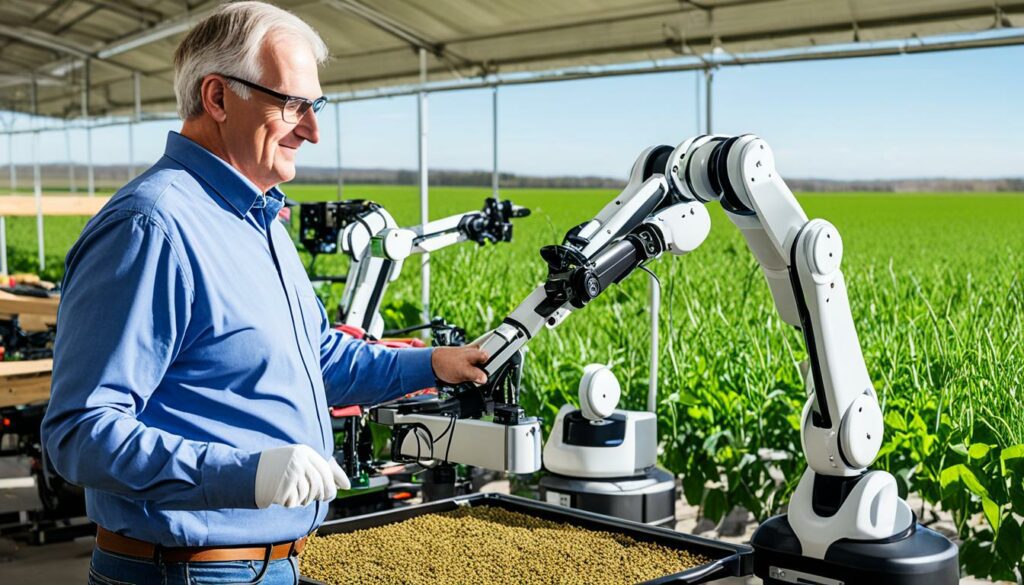
AI and automation are leading this change in agriculture. They’re blending in with farming to offer futuristic agricultural solutions. Think of robots helping plant and harvest or systems that watch how workers move. These ergonomic innovations in farming are set to cut back on injuries like MSDs.
Studying the trends, we see a growing interest in this area. Let’s look at the numbers:
| Period | Studies Per Year |
|---|---|
| 1980 to 2017 | Mean of 2.89 studies/year |
| 2018 onwards | Significant increase |
Improving worker safety in agriculture is key. We’re not just upgrading how we work but also how we take care of our health. Even small changes have made a big impact on worker comfort. With time, these new tools will get even better and safer.
Looking at how farm machinery is designed highlights the need for careful planning. For example, making sure tools are good for the knees and hips can help prevent health issues. This comes from detailed ergonomic checks.
The future for farming ergonomics is all about smart tech and safety. The vast amount of research shows this. We’re aiming to turn tech advancements into real-world, safe solutions for farmers.
Ergonomic case studies help us see how practical ergonomic changes benefit farmers. The farming sector faces many risks, making ergonomics crucial for safety. Targeted ergonomic plans help fight musculoskeletal disorders (MSDs) among farm workers.
Reducing low back pain and OA among farm workers is a big success in ergonomics. Factors like obesity, being female, and low education lead to these issues. Solutions include using smaller tools for certain tasks and changing the design of ladders. This has cut down on worker pain.
Useful tools like long-handled hoes and powered cutters have also helped lower MSD risks. They make tough farm jobs easier, reducing the chance of injuries. Different tasks need different ergonomic designs to stay safe.
Letting workers take breaks helps counteract the effects of bad postures, an essential part of good ergonomics. Recent studies back up how effective these approaches are. This shows the value of ergonomic strategies in farming.
In Italy, in-field accidents are a major issue, with a high fatality rate. Many of these accidents are due to tractor safety systems not being used properly. Solutions are being looked at to make these systems work better and keep workers safer.
Some farmers have been found to act unsafely because of problems with tractor safety designs. Fixing these flaws requires making things easier for farmers. Some suggest new safety designs specially made to stop misuse, but this needs to be both technically and economically possible.
To sum up, focusing on ergonomics in farming improves safety, comfort, and output. With the right ergonomic changes, farming can be a healthier and more efficient job. This is good news for everyone working in agriculture.
Using ergonomic best practices in agriculture can make the work safer and more productive. Agriculture is the second most risky job when it comes to injuries and illnesses. It’s key to use strategies that make the work environment better. This is crucial because many farm workers suffer from muscle and joint problems. These problems are often made worse by doing the same movements over and over again and working in awkward positions.
For example, making changes like using smaller tubs for grapes and adjusting ladder steps for orchard work helps a lot. These changes may seem small but they make a big difference. They can lower the chance of workers getting hurt and reduce how much they hurt during work.
A tool like a long-handled hoe for weeding can help too. It makes people bend their back less, which means they’re less likely to get muscle or joint issues. This tool also helps get the job done faster and more easily. Also, cutters that work on air power can let people with some physical limits keep doing their job without hurting themselves.
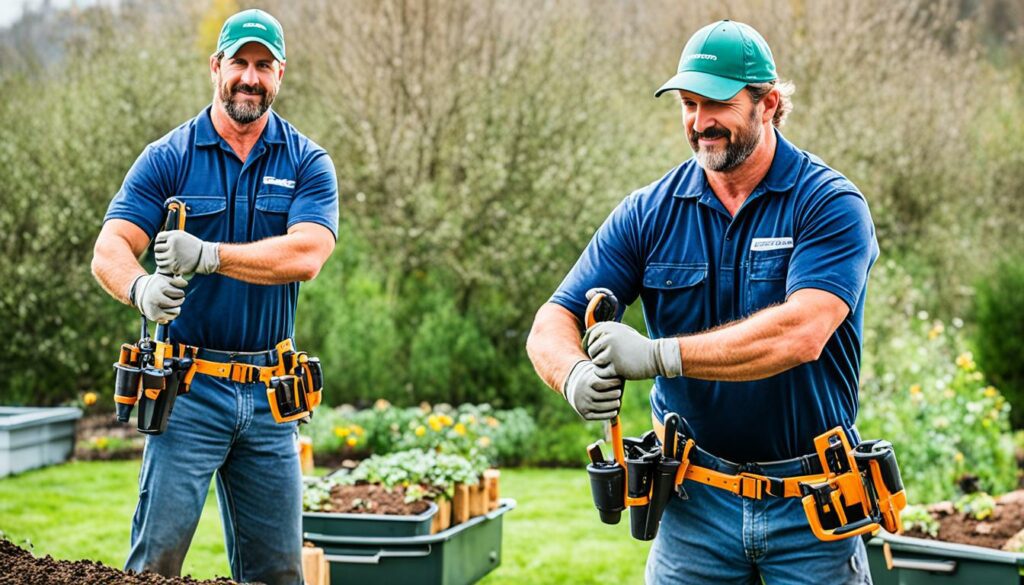
It’s also very important to take short breaks from tasks that make you bend over a lot. These breaks can stop your muscles from tightening up and causing long-term pain. Teaching workers about the best ways to work can help them use tools and machines safely. This means fewer injuries on the job.
Studies have shown that these ways of working are really helpful. But, there’s still a lot more to learn about the best practices. We need to keep researching how to make farming work healthier and safer. Fortunately, more and more people are looking into this area since 2018. So, it’s becoming clear that good farming ergonomics are very important.
| Intervention | Benefit |
|---|---|
| Smaller tubs for grape harvesting | Reduced worker strain |
| Reduced ladder rung spacing | Enhanced safety and reduced pain |
| Long-handled hoes for weeding | Decreased trunk flexion and increased productivity |
| Pneumatically-powered cutters | Enabling work for partially disabled workers |
Finally, it’s about always wanting to improve. Thinking about and checking that we’re doing things the best we can is key. There’s a lot we still need to figure out. But, with more knowledge and new tools, we can make farming work a lot better. This is important not just for the work, but for keeping workers safe and happy too.
It’s crucial to know the productivity benefits of ergonomics in agriculture due to its high risks. The agriculture sector ranks second in work-related injuries and illnesses. This shows how tough farm work is on workers. A big issue is musculoskeletal disorders (MSDs), especially low back pain. This is often caused by lifting things repeatedly, staying bent forward for too long, working hard with the hands, and being in awkward positions.
But, making small changes in the work environment can help a lot. These changes often reduce the pain and the number of injuries reported. This shows the power of efficient ergonomic practices. They improve health and make work more productive. For example, when workers bend their knees a lot, they might develop knee and hip problems. But, finding ways to avoid this can help agriculture workers a great deal.
Seeing the clear benefits of ergonomic measures is very convincing. Fewer injuries mean more work gets done and workers don’t get as tired. Research from 2010 to 2019 clearly shows that more studies are focusing on making agriculture work safer and more comfortable. This research is crucial in showing the real effect of using ergonomic solutions.
Let’s look at some figures: Out of 1956 records found in searches, 617 studies were seen as useful. From 1980 to 2017, an average of 2.89 studies were found each year. But, this number rose a lot after 2018. This increase in research proves that the industry sees the value of ergonomics. It stresses the need for efficient ergonomic practices to protect workers and improve how work is done.
Agriculture is risky, with many getting hurt or sick, second only to construction. Because of this, there are strict safety rules, especially for the health of farm workers. Back problems and MSDs are common, but using the right tools can help prevent these issues.
Back pain is a big problem for those working in agriculture. They also often suffer from joint problems like knee and hip osteoarthritis. Thanks to new tools and approaches, the number of these health issues is decreasing.
Over ten years, 27 crucial articles were analysed from resources like Google Scholar and PubMed. These studies, also looking at MSDs, suggest ways to make agricultural work safer. They are very important for improving safety rules for farms.
The NIOSH AFF Program studies data, aiming to reduce dangers in farming. It looks into injuries among not just farmers but also their hired help and their families. This effort pushes research to better protect those in agriculture.
From the NIOSH AFF Program, we can see what needs more study, like using new tech safely or working around GMOs and fast machines. But, keeping up with new problems is hard, especially if time and money are spent on old issues.
Projects in places like Alaska and for child safety show that steady funding and keeping experts are key to success. A committee suggests working together more, especially on problems like night shifts and cancer risks, to make farming safer.
Looking forward, new tech, like using genetic markers, could help prevent diseases on the job. But, this must be done carefully to protect privacy and be fair. This work aims at making farms safer without forgetting about the people’s needs.
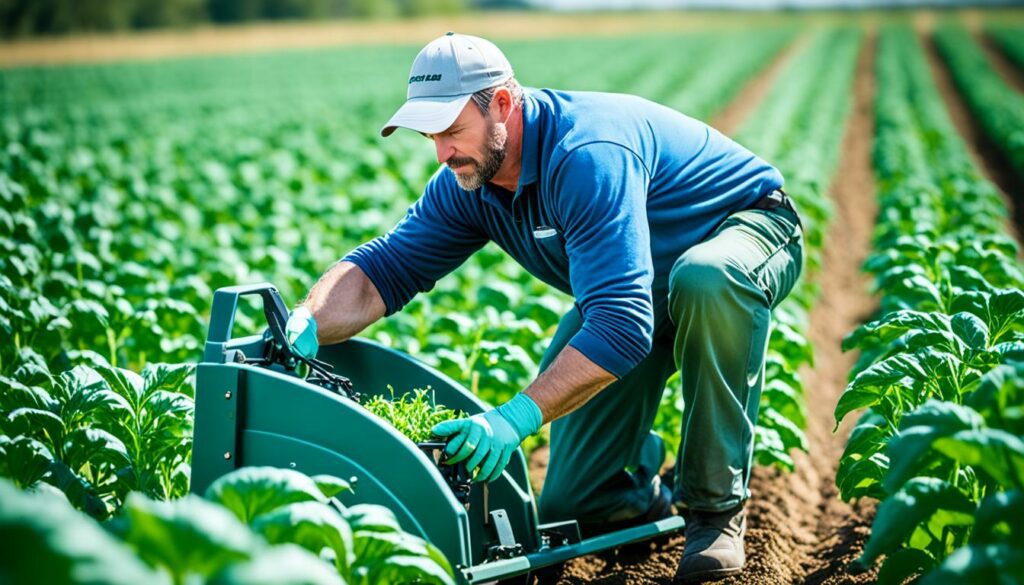
Around the world, there are 1.3 billion farm workers. Only 9% are in rich countries. This makes safety rules and new tools very important for the majority working in poor nations. Good regulations and tools are crucial for farm workers everywhere to stay healthy and safe.
The world of agricultural ergonomics needs us to think in many different ways. Looking at it, we see that injuries and health problems are still a big issue. This is especially true for a field like agriculture, where dangers are high. So, it’s clear we need smart ways to make work safer and easier for farmers.
Many farm workers get hurt or face pain, especially in their backs and knees. These problems get worse as they get older, if they’re overweight, are women, or have less education. But, we have found that making changes in how we work can help a lot. For instance, making tools longer or changing how we pick grapes has helped to lower the risks. This means that even people with physical challenges can join in working on the farm in safe ways.
After studying 123 pieces of research, found mostly after 2018, we see a lot of new interest in ergonomics for farming tools. There have been great improvements in how we make machines, considering who will use them. This includes taking into account things like gender, age, and where a person is from. Such steps are key for the future of keeping farmers safe while they work.
In the end, combining smart ergonomics with new tech is the way forward for farming. We must keep making changes that help both the health and work of farmers. With everyone working together, we can make farming a place that’s not just productive but also healthy and safe.
Future trends in agricultural ergonomics will use AI and automation for better worker safety and comfort. These innovations aim to make farming tasks better and prevent injuries.
Ergonomic assessment is key in farming to spot risks that cause health issues. It makes jobs fit the physical needs of workers, improving health and work.
AI in farming analyses risks like bad postures. It uses real-time data to make designs better, cutting fatigue and injuries.
Wearable sensors check how workers move and sit. They help spot risks fast, making work safer and stopping health issues.
To fight MSDs, sustainable farming designs tools and work methods better. These changes help workers stay well and work better, meeting green goals.
Automating farm work cuts down hard, repeating jobs. This helps lessen physical effort and makes work safer.
Economic machinery designs focus on worker comfort, simple use, and being safe. They aim to cut down work strain and prevent injuries.
Digital tools keep an eye on worker moves and postures. They help fix issues quickly, making work safer and more productive.
Lately, farming smartly with tech helps manage crops well and work more safely. It aims to reduce body strain on workers.
Strategies include looking at risks thoroughly and finding ways to avoid them. They also focus on making sure machines and people work safely together.
To make farming safer, we need to solve complicated machine designs and handle changes in work and weather. New, smarter ergonomic ways must keep up.
Future tech like AI and wearable tools will make farming safer and more efficient. They aim to lower accidents, boost happiness, and work better.
Case studies show how careful planning can boost worker safety and job satisfaction. They prove the real benefits of making work conditions better.
Using safe machinery, ongoing training, and setting safety rules are key. They improve the workplace and how workers use tools safely.
By lowering injuries and tiredness, ergonomic changes make work more efficient. This better work conditions leads to more work done and saves money for farms.
Rules set by policy strive for a safer workplace for farmers, adapting to new tech. They keep workers healthy and safe in changing farms.